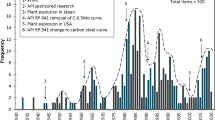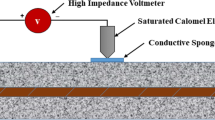Abstract
In the present study, the fatigue crack propagation (FCP) tests were conducted on X80 steel in air and artificial seawater (ASW) under various applied potentials to establish optimum and safe working limits of cathodic protection (CP). The slow strain rate test (SSRT) was also conducted on the X80 BM specimens in ASW under CP potential to identify the susceptibility of hydrogen affecting the FCP behavior. The CP potential of −850 and −1,050 mVSCE suppressed the environmental effect of seawater on the FCP behavior of X80 BM and WM specimens, showing almost identical da/dN-ΔK curves for both air and ASW environments. The SSRT in ASW under CP potential of −1,050 mVSCE suggested that the X80 BM specimen steel is susceptible to hydrogen embrittlement, but the effect of hydrogen was believed to be marginal in affecting the FCP behavior of the X80 specimens at a loading frequency of 10 Hz. The FCP behavior of high strength X80 steel is discussed based on the fractographic observation to understand the FCP mechanism in seawater under various CP potentials.
Similar content being viewed by others
References
W. Wang, Y. Shan, and K. Yang, Mater. Sci. Eng. A, 502, 38 (2009).
S. Y. Shin, S. M. Hong, J. H. Bae, K. S. Kim, and S. H. Lee, Met. Mater. Int. 47, 155 (2009).
Y. Wang, W. Zhao, H. Ai, X. Zhou and T. Zhang, Corros. Sci. 53, 2761 (2011).
R. F. D. Silva, F. A. F. Teófilo, E. Parente Jr., A. M. C. D. Melo, and Á. S. D. Holanda, Mar. Struct. 33, 1 (2013).
M. Katsumi and O. Kenji, JFE Technology Report, No. 18 (2013).
Y. Bai and Q. Bai, Subsea Pipelines and Risers, pp.413–451, Elsevier, Kidlington (2005).
D. P. Baxter, S. J. Maddox, and R. J. Pargeter, 26th Int. Conf. on Offshore Mech. & Arctic Eng., p.117, ASME, Sand Diego, USA (2007).
NORSOK, NORSOK Standard M-001 (2004).
C. Lindley and W. J. Rudd, Mar. Struct. 14, 397 (2001).
J. Billingham, J. V. Sharp, J. Spurrier, and P. J. Kilgallon, Health and Safety Executive (HSE) Books, Research Report 105, Cranfield University, Cranfield (2003).
NORSOK, NORSOK Standard M-503 (2007).
J. Prey, R. W. Barrett, and J. N. Wanklyn, Design and Operational Guidance on Cathodic Protection of Offshore Structures, Subsea Installations and Pipelines, Energy Institute, London (1990).
M. Cabrini, S. Lorenzi, P. Marcassoli, and T. Pastore, Corros. Rev. 29, 261 (2011).
ASM International Handbook Committee, ASM Handbook 19 — Fracture and Fatigue Properties of Structural Steels, ASM International (1996).
M. N. James, J. Eng. Design, 9, 329 (1998).
J. K. Kwon, Y. J. Kim, S. Z. Han, M. Goto, and S. S. Kim, Met. Mater. Int. 15, 925 (2009).
S. S. Kim, J. K. Kwon, N. S. Woo, S. E. Chung, and Y. J. Kim, Met. Mater. Int. 19, 1 (2013).
D. H. Jeong, S. G. Lee, W. K. Jang, J. K. Choi, Y. J. Kim, and S. S. Kim, Metall. Trans. A, 44A, 4601 (2013).
S. S. Kim, J. T. Burns, and R. P. Gangloff, Eng. Fract. Mech. 76, 651 (2009).
British Standard, Guide to Methods for Assessing the Acceptability of Flaws in Metallic Structures, British Standards Institution (BSI), BS 7910, London (2005).
R. N. King, Health, and Safety Executive (HSE) Books, OTH 511 (2003).
R. N. King, A. Stacey, and J. V. Sharp, 15th International Conference Offshore Mechanics and Arctic Engineering, pp.341–348, Florence, Italy (1996).
S. A. Shipilov and I. L. May, Eng. Fail. Anal. 13, 1159 (2006).
R. Murakmi and W. G. Ferguson, Fatigue Fract. Eng. Mater. Struct. 9, 477 (1987).
P. S. Pao, S. J. Gill, C. R. Feng, and K. K. Sankaran, Scr. Mater. 45, 605 (2001).
A. K. Vasudevan and S. Suresh, Metall. Trans. A, 13A, 2271 (1982).
ASTM Standard G5, Standard Reference Test Method for Making Potentiostatic and Potentiodynamic Anodic Polarization Measurements, Annual Book of ASTM Standards.03.02 (2002).
ASTM Standard D1141, Standard Specification for Substitute Ocean Water, Annual book of ASTM Standards.11.02 (1990).
ASTM Standard E647, Standard Test Method for Measurement of Fatigue Crack Growth Rates, Annual Book of ASTM Standards.03.01 (2002).
ASTM Standard G129, Standard Practice for Slow Strain Rate Testing to Evaluate the Susceptibility of Metallic Materials to Environmentally Assisted Cracking, Annual Book of ASTM Standards.03.02 (2006).
J. S. Warner, S. S. Kim, and R. P. Gangloff, Int. J. Fatigue, 31, 1952 (2009).
W. Zhao, R. Xin, Z. He, and Y. Wang, Corros. Sci. 63, 387 (2012).
D. A. Jones, Metall. Trans. A, 16A, 1133 (1985).
S. A. Shipilov, Critical Assessment of the Rule of Cathodic Protection in Pipeline Integrity and Reliability, P. E. J. Flewitt et al. Eds., Engineering Structural Integrity Assessment, pp.155–162, Need and Provision, Sheffield (2002).
Y. G. Chun and S. I. Pyun, Fatigue Fract. Engng. Mater. Struct. 18, 661 (1995).
S. H. Chung, J. K. Lim, and E. G. Na, KSME J. 3, 1 (1989).
P. Liang, X. Li, C. Dua, and X. Chen, Mater. Des. 30, 1712 (2009).
D. H. Jung, J. K. Kwon, N. S. Woo, Y. J. Kim, M. Goto, and S. S. Kim, Metall. Trans. A, 45A, 654 (2014).
S. Ritter and H. P. Seifert, J. Nucl. Mater. 375, 72 (2008).
M. Cabrini, S. Lorenzi, P. Marcassoli, and T. Pastore, Corros. Rev. 29, 261 (2011).
J. Yu, R. Brook, I. Cole, D. Morabito, and G. Demofonti, Fatigue Fract. Engng Mater. Struct. 19, 1019 (1996).
B. Huneaua and J. Mendez, Int. J. Fatigue, 28, 124 (2006).
M. N. Ilman, Inter. J. Fatigue, 62, 228 (2014).
P. Liang, X. Li, C. Dua, and X. Chen, Mater. Des. 30, 1712 (2009).
A. Torres-Islas, J. G. Gonzalez-Rodriguez, J. Uruchurtu, and S. Serna, Corros. Sci. 50, 2831 (2008).
M. A. Arafin and J. A. Szpunar, Mater. Sci. Eng. A, 528, 4927 (2011).
Y. J. Kim, J. K. Kwon, Y. I. Jeong, N. S. Woo, and S. S. Kim, Met. Mater. Int. 19, 19 (2013).
H. J. Lee, Y. J. Kim, Y. I. Jeong, and S. S. Kim, Corros. Sci. 55, 10 (2011).
Author information
Authors and Affiliations
Corresponding author
Rights and permissions
About this article
Cite this article
Kim, Y., Kwon, J., Jeong, D. et al. Effect of applied potential on fatigue crack propagation behavior of API X80 steel in seawater. Met. Mater. Int. 20, 851–858 (2014). https://doi.org/10.1007/s12540-014-5009-7
Received:
Accepted:
Published:
Issue Date:
DOI: https://doi.org/10.1007/s12540-014-5009-7




